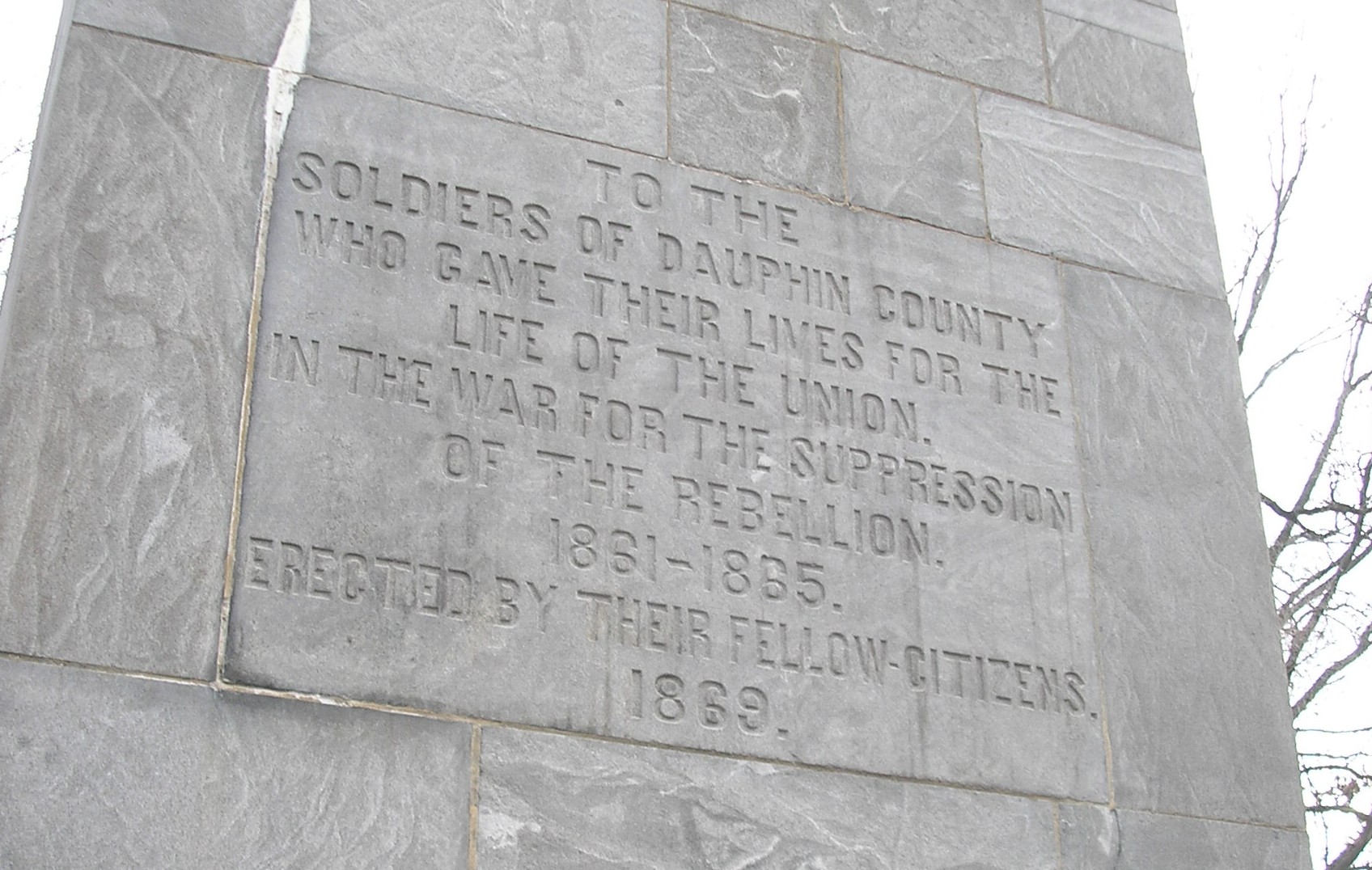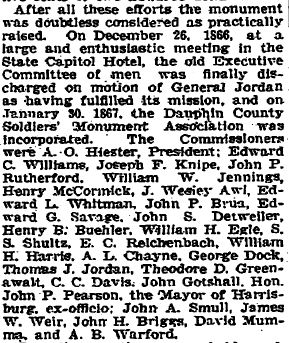History of the Dauphin County Civil War Monument – Part 4
Posted By Norman Gasbarro on March 23, 2012
Part 4. The Dauphin County Memorial to the Civil War is currently located in a park at 3rd Street and Division Streets near William Penn High School and near Italian Lake. It is now in the Uptown section of Harrisburg, north of what was once the entrance area to Camp Curtin. The monument stands about 110 feet high and is a single obelisk which resembles a smaller version of the monument to George Washington in Washington, D.C. The stone of the monument is native to the area and was cut from the banks of the Susquehanna River.
The monument was originally located at the intersection of North 2nd Street and State Streets but in 1960, after years of deterioration, it was cleaned and restored and moved to the park where it presently resides.
While the monument inscription indicates that it was originally erected in 1869, the fact is that it was not completed until 1876 and before its completion, the “pile of stone” was an eyesore and embarrassment in downtown Harrisburg. The long, difficult struggle to get funding for the monument and complete it in a reasonable amount of time after the war will be discussed in a series of five posts that began on 13 March 2012.. The story is told as reported in the Harrisburg Patriot, 25 December 1903.
THE INTERESTING STORY OF THE STATE STREET MONUMENT
How the Great Shaft Was Raised as a Memorial to Dauphin County’s Soldiers and Sailors in the Civil War
After all these efforts the monument was doubtless considered as practically raised. On 26 December 1866, at a large and enthusiastic meeting in the State Capitol Hotel, the old Executive Committee of men was finally discharged on motions of Gen. Jordan as having fulfilled its mission, and on 30 January 1867, the Dauphin County Soldiers’ Monument Association was incorporated.
The Commissioners were: A. O. Heister, President’ Edward C. Williams, Joseph F. Knipe, John P. Rutherford, William W. Jennings, Henry McCormick, J. Wesley Awl, Edward L. Whitman, John P. Brua, Edward G. Savage, John S. Detweiler, Henry B. Buehler, William H. Egle, S. S. Shultz, E. C. Reichenbach, William H. Harris, A. L. Chayne, George Dock, Thomas J. Jordan, Theodore D. Greenawalt, C. C. Davis, John Gotshall, Hon. John P. Pearson, the Mayor of Harrisburg, ex-officio; John A. Smull, James W. Weir, John H. Briggs, David Mumma, and A. B. Warford.
Executive meetings were held each week, Dr. Egle being made Secretary, and George Small, Treasurer. The chairman of the old committee declined to turn over the subscription books and other documents on the grounds that they were private property, but the difficult was soon adjusted. Henry McCormick, John H. Briggs and James H. Weir were made a finance committee. Messrs. Hiester, McCormick, Briggs, Williams and Chayne a building committee, and Messrs. Shultz, Dock and Weir a committee on the inscription.
Nine Designs to Choose From
Plans for a monument not to exceed $15,00 in cost were advertised for and a premium of $100 offered for the one accepted. On 6 April the choice was made. Nine designs were sent in ranging from the simple obelisk to the highly ornamental mausoleum, or a bronze statue representing one of our country’s defenders planting a flag on a fortress. Among them was the design of Hamilton Atricks, afterward used for the Mexican Monument. Most of these plans were by Harrisburgers. The committee by a majority of votes adopted the design of Hudson Worrell as he had made the lowest estimate. It called for a plain stone obelisk, 110 feet high, the stones set with leaden points and surrounded by a stone coping.
Then came a great discussion of sites, everyone having a favorite spot as the best possible place for the monument, Harris Park, the cemetery, Camp Curtin, Allison Hill, Capitol Hill between the Land Office and the Arsenal on a spot reserved for the Governor’s House; Third Street in front of the Capitol, Market Square and several locations on Front Street between Market and State were offered. No decision being reached. Colonel McCormick on 27 April offered a resolution to submit the question to the Ladies of the Soldiers’ Fair Committee, and ask them to choose the site. James W. Weir, A. O. Heister and John H. Briggs being appointed a committee to inform them.
The ladies having speedily made their choice, Councils on 16 May 1867, voted the ground at the intersection of State and Second Streets, though there was some question of their right to devote the land to country purposes: and bids were advertised to be in by 1 July.
Then came a halt. Nothing more was heard of the monument for months. In the meantime, ground was broken for the Mexican Monument on 15 July, which was completed by 13 June 1869, and on 11 June 1867, there was dedicated in the cemetery at Hummelstown, with much pomp and ceremony a soldiers’ monument, the first ever raised in Dauphin County. Gov. Geary and a number of distinguished officers were present, and Col. A. J. Herr delivered the oration.
The contract for the monument at State Street was finally awarded on 15 October 1867 to Henry Brown, a marble dealer of this city, who had his yard on the site of the present Cumberland Vally Railroad offices. He was to receive $11,000 for his work.
The next week, on Wednesday, 23 October 1867, ground was at last broken for the soldiers’ monument, which had been the chief object of discussion in the county for twenty-two months. It was made quite and event. The ground was carefully surveyed and marked off at each corner by a flag-staff; the surrounding houses and the Hope engine House were gaily decorated; a rostrum was erected, and on it were seated Gov. Geary, the Hon. John H. Briggs, President of the Building committee, the Secreatry, Dr. Egle, Dr. Thomas H. Robinson, the Rev. Father Maher and many members of the Monument Commission and of the board of the Soldiers’ Fair. After a prayer by Dr. Robinson, the reading of the Act of Assembly by Dr. Egle, and an address by Gov. Geary, the Governor descended from the platform and took out the first shovel of ground, pledging the people “to the completion and preservation of the monument that it might show to future generations the gratitude of those who built it to those who perished, that the government might be preserved.” Three soldiers of the war of 1812, David Krouse, William Bostwick and Andrew Krouse then dug out other shovels full, and the ceremonies were finished with a prayer by Father Maher.
The completion of the main shaft was promised for early in the next year, but the months came and went and still no sign of the monument. The dail papers began to wax caustic, and at last on 7 July 1868, A. L. Chayne, Sehayne, Secretary of the Building Committee, came out in a note to the public stating that the work would be resumed at once, as the committee had conferred with Mr. Brown and he had agreed the work should be prosecuted as soon as possible.
By 14 August, four men were employed in dressing the granite. On 10 October there was a meeting to make arrangements for the corner stone laying. Still the papers grew eloquent over the delayed work. On 10 April 1869, the long-looked for day of laying the corner stone had arrived, and the most was made of it.
At high noon the important feat was accomplished, according to then ancient rites and usages of Free Masonry, Perseverance Lodge, No. 21, representing the Grande Lodge of Pennsylvania. The Lodge met at 11 o’clock, leaving the hall at 11:30, accompanied by Weber’s Band. A platform, 16 by 33 feet, was erected and on it were the commissioners and Building Committee for the Monument, and the officers of the Grand Lodge of Masons.
The following brethren took part in the ceremonies: Robert A. Lamberton, R. W. G.M.; Thomas J. Jordan, R.W.D.G.M.; Joshua M. Wiestling, R.W.S.G.W; Robert Snodgrass, R.W.J.G.W; William Sayford, R.W.G. Treasurer; William T. Egle, R.W.G. Secretary; Rev. James Calder, R.W.G. Chaplain; Joseph N. Nisley, R.W. Sen. G. Deacon; Franklin Darby, R.W. Jun. Deacon; James Worrall, R.W.G.Steward; Samuel D. Ingram, R.W.G.Steward; S. P. Auchmuter, R.W.G. Steward;; Theodore F. Scheffner, R.W.W. Sword Bearer; William Kuhn, R.D.G. Pursuivant; Samuel N. Coleman, R.W.G. Tyler.
After a prayer by the Rev. James Calder, the reading of the Monument ordinance by Gov. Geary, and music by Weber’s Band, Hon. A. O. Hiester, Chairman of the Monument Building Committee, turned the ceremonies over into the hands of the Masons. The Right Worthy Grand Master Lamberton, in the course of an eloquent speech, inaugurating the ceremonies said: —
“This monument is to be erected to the gallant dead of this county. It is to commemorate their valor and patriotism. It is to tell through the centuries of the future, to our children and theirs, for all time, that the brave who offered up their lives in defense of this Government of the people, are not and shall not be forgotten. And so, we, as Free Masons, gladly unite to lay the corner stone of a structure whose purpose is to perpetuate the memory of the soldiers of Dauphin whose rest is the sleep of the patriotic dead.”
The story of the monument will conclude tomorrow.
 ;
;




Comments